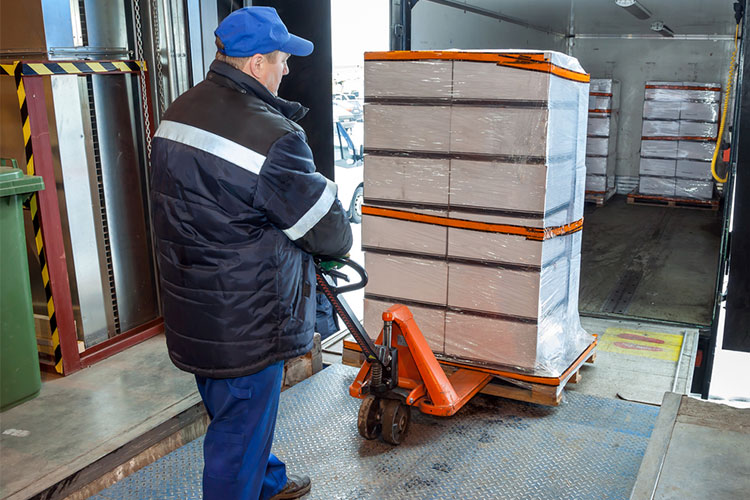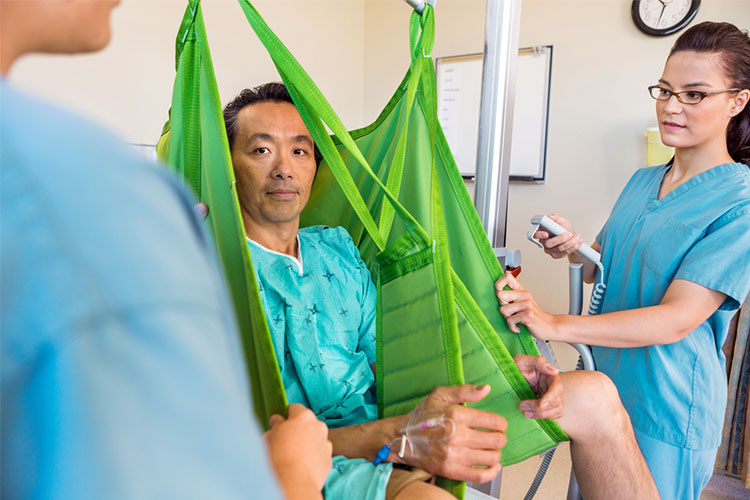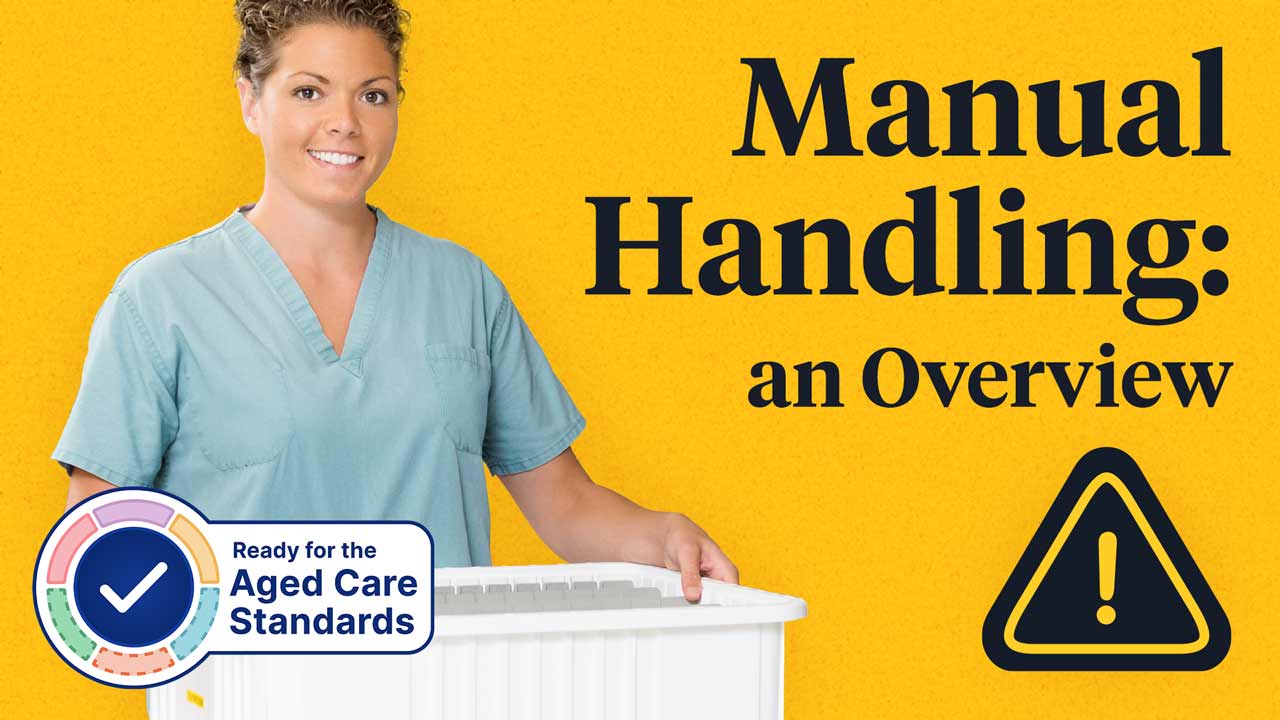Did you know that the rate of manual handling injuries is 58.9% in healthcare compared to 43.9% across all other industries (WorkSafe Victoria 2007)?
Workplace injuries are common in healthcare, and there are many occupational health and safety risks inherently associated with working in the health sector.
This article will look at how you can reduce the risk of injury when performing manual handling tasks.
Note: the intention of this article is to provide an overview of manual handling. However, further reading is essential. Refer to the resources listed at the end of the article for more information. It is crucial that you receive appropriate, practical manual handling training and supervision from your facility. You must also follow workplace policies and procedures and be familiar with relevant state/federal legislation.
What is Manual Handling?
Manual handling includes any activity carried out in the workplace that requires the use of force. It encompasses acts such as:
- Lifting
- Pushing
- Lowering
- Pulling
- Moving
- Holding
- Restraining
- Carrying
(SafeWork NSW 2023)

What are Hazardous Manual Handling Tasks?
Hazardous manual handling tasks are those that involve one or more of the following:
- Repetitive movements
- Sustained or repetitive force
- High or sudden force
- Awkward or sustained posture
- Exposure to vibration
(SafeWork NSW 2023)
Manual Handling Risks in Healthcare
Manual handling can result in significant or irreversible injuries, particularly musculoskeletal injuries, which may include:
- Soft tissue injuries e.g. hernias
- Nerve damage or compression e.g. carpal tunnel syndrome
- Back and neck injuries
- Bone and joint injuries to hands, feet, shoulder, wrist, hip, knee, ankle etc.
- Ligament and tendon damage
- Muscle sprains and strains
- Muscular and vascular disorders
- Chronic pain
- Acute pain
(Safe Work Australia 2018, 2023)
Factors related to manual handling tasks that increase the risk of injury include:
- Fatigue (both physical and mental)
- Loads that are unstable, unbalanced, or awkward to grasp and move
- Inadequate staff training
- Low staffing levels
- Handling people or animals
(Safe Work Australia 2018; WorkSafe Victoria 2023)

Manual Handling Under the Strengthened Aged Care Quality Standards
Standard 2: The Organisation - Outcome 2.2: Quality and safety culture (Action 2.2.2) of the strengthened Aged Care Quality Standards requires an aged care organisation’s governing body to prioritise their staff's safety, health, and wellbeing - naturally, this includes manual handling safety (ACQSC 2024).
Additionally, Outcome 2.4: Risk management (Action 2.4.1) states that providers must implement a risk management system to recognise, document, address, and monitor risks to their staff (ACQSC 2024).
Managing Manual Handling Risks
Read: Risk Assessment and Management in the Home
Abide by these four steps to effectively manage hazards associated with manual handling tasks:
1. Identify hazards
- Inspect the workplace
- List the hazards you find
- Talk to other workers
- Review information about workplace injuries and incidents.
2. Assess the risk(s)
Identify the following in relation to the task:
- Its weight
- The movements involved
- The duration of the task
- Whether the task requires high or sudden force
- Whether the task involves vibration.
3. Control the risk(s)
Using the hierarchy of controls, apply the following methods of hazard prevention in order of highest protection to lowest protection:
- Elimination
- Substitution
- Isolation
- Engineering
- Administrative actions
- Personal protective equipment.
4. Review risk controls
Implemented control measures should be reviewed and, if necessary, revised.
(WorkSafe.qld.gov.au 2020)
Methods to Prevent Injury During Manual Handling
- If possible, lighten loads by breaking them into smaller quantities
- Warm up before performing manual handling tasks
- Take breaks
- Allow time to get used to a new task
- Explore ways to minimise lifting heavy items
- Reduce or avoid bending, twisting, reaching movements
- Move your feet rather than twisting your back
- Give specific muscles a break by changing tasks during long shifts
- Avoid rushing tasks
- Use the appropriate equipment and assistive devices correctly, and use mechanical aids when possible
- Do not use poorly maintained equipment or equipment you have not been trained for
- Do not be afraid to ask for help and use teamwork
- Watch out for and support peers to care for themselves in the workplace
- Attend and advocate for regular training on manual handling
- Abide by workplace manual handling policies and guidelines
- Abide by the principles of proper body alignment and body mechanics
- Learn how to recognise activities that have the potential for injury and act to reduce the risk
- Avoid performing high-risk activities
(WorkSafe 2017; de-Vitry Smith 2021; vic.gov.au 2024)
Always question outdated procedures and practices, and don’t be afraid to speak up if you perceive a risk to you or your coworkers.

Review Relevant State/Federal Legislation
You should be familiar with (and thus refer to) relevant state/federal legislation that stipulates the roles of both employers and employees.
All workplaces should have policies and procedures on manual handling and hazard, incident and injury reporting. The Work Health and Safety Act 2011 applies to employees and employers. Under the work health and safety legislation, breaches of duty could result in penalties.
Disclaimer: This article is to be used in conjunction with your organisation’s policies and procedures regarding manual handling. This article does not replace the theory of mandatory training regarding manual handling from your organisation. Appropriate theoretical and practical training in manual handling in your workplace should be provided by your employer.
Test Your Knowledge
Question 1 of 3
True or false: The rate of manual handling injuries is higher in healthcare than in other industries.
Topics
Further your knowledge
 Free
Free Free
Free Free
Free
References
- Aged Care Quality and Safety Commission 2024, Standard 2: The Organisation, Australian Government, viewed 15 April 2024, https://www.health.gov.au/resources/publications/strengthened-aged-care-quality-standards-august-2025?language=en
- de-Vitry Smith, S 2021, ‘Manual Handling Safety’, Ausmed, 23 June, viewed 15 April 2024, https://www.ausmed.com.au/cpd/courses/manual-handling-safety
- SafeWork NSW 2023, Hazardous Manual Tasks, New South Wales Government, viewed 15 April 2024, https://www.safework.nsw.gov.au/hazards-a-z/hazardous-manual-tasks
- Safe Work Australia 2018, Hazardous Manual Tasks Code of Practice, Australian Government, viewed 15 April 2024, https://www.safeworkaustralia.gov.au/system/files/documents/1905/model-cop-hazardous-manual-tasks.pdf
- Safe Work Australia 2023, Lifting, Pushing and Pulling (Manual Tasks), Australian Government, viewed 15 April 2024, https://www.safeworkaustralia.gov.au/safety-topic/hazards/lifting-pushing-and-pulling-manual-tasks
- vic.gov.au 2024, Manual Handling, Victoria State Government, viewed 15 April 2024, https://www.vic.gov.au/safework/safework-general-module/manual-handling
- WorkSafe 2017, Preventing Manual Handling Injuries - Fact Sheet, New Zealand Government, viewed 15 April 2024, https://www.worksafe.govt.nz/topic-and-industry/manual-handling/preventing-manual-handling-injuries-fs/
- WorkSafe.qld.gov.au 2020, Managing Risks, Queensland Government, viewed 15 April 2024, https://www.worksafe.qld.gov.au/safety-and-prevention/creating-safe-work/managing-risks
- WorkSafe Victoria 2007, A Guide to Designing Workplaces for Safer Handling of Peoplev, WorkSafe Victoria, viewed 15 April 2024, https://content.api.worksafe.vic.gov.au/sites/default/files/2018-06/ISBN-Designing-workplaces-for-safer-handling-of-people-guide-2007-09.pdf
- WorkSafe Victoria 2023, Hazardous Manual Handling: Safety Basics, Victoria State Government, viewed 15 April 2024, https://www.worksafe.vic.gov.au/hazardous-manual-handling-safety-basics
 New
New 
